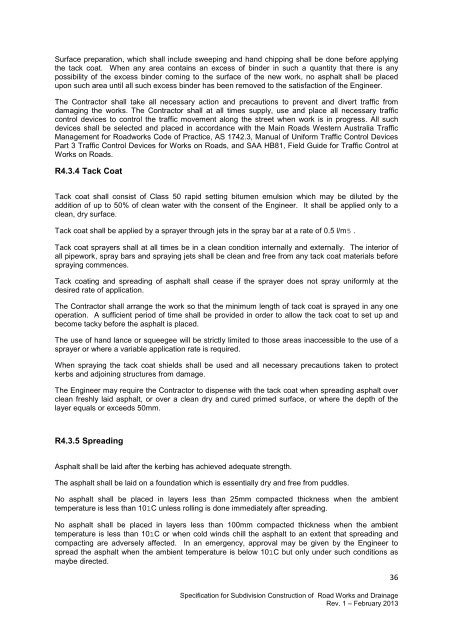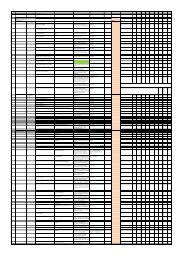specification for subdivision construction of road works and drainage
specification for subdivision construction of road works and drainage
specification for subdivision construction of road works and drainage
Create successful ePaper yourself
Turn your PDF publications into a flip-book with our unique Google optimized e-Paper software.
Surface preparation, which shall include sweeping <strong>and</strong> h<strong>and</strong> chipping shall be done be<strong>for</strong>e applying<br />
the tack coat. When any area contains an excess <strong>of</strong> binder in such a quantity that there is any<br />
possibility <strong>of</strong> the excess binder coming to the surface <strong>of</strong> the new work, no asphalt shall be placed<br />
upon such area until all such excess binder has been removed to the satisfaction <strong>of</strong> the Engineer.<br />
The Contractor shall take all necessary action <strong>and</strong> precautions to prevent <strong>and</strong> divert traffic from<br />
damaging the <strong>works</strong>. The Contractor shall at all times supply, use <strong>and</strong> place all necessary traffic<br />
control devices to control the traffic movement along the street when work is in progress. All such<br />
devices shall be selected <strong>and</strong> placed in accordance with the Main Roads Western Australia Traffic<br />
Management <strong>for</strong> Road<strong>works</strong> Code <strong>of</strong> Practice, AS 1742.3, Manual <strong>of</strong> Uni<strong>for</strong>m Traffic Control Devices<br />
Part 3 Traffic Control Devices <strong>for</strong> Works on Roads, <strong>and</strong> SAA HB81, Field Guide <strong>for</strong> Traffic Control at<br />
Works on Roads.<br />
R4.3.4 Tack Coat<br />
Tack coat shall consist <strong>of</strong> Class 50 rapid setting bitumen emulsion which may be diluted by the<br />
addition <strong>of</strong> up to 50% <strong>of</strong> clean water with the consent <strong>of</strong> the Engineer. It shall be applied only to a<br />
clean, dry surface.<br />
Tack coat shall be applied by a sprayer through jets in the spray bar at a rate <strong>of</strong> 0.5 l/m5 .<br />
Tack coat sprayers shall at all times be in a clean condition internally <strong>and</strong> externally. The interior <strong>of</strong><br />
all pipework, spray bars <strong>and</strong> spraying jets shall be clean <strong>and</strong> free from any tack coat materials be<strong>for</strong>e<br />
spraying commences.<br />
Tack coating <strong>and</strong> spreading <strong>of</strong> asphalt shall cease if the sprayer does not spray uni<strong>for</strong>mly at the<br />
desired rate <strong>of</strong> application.<br />
The Contractor shall arrange the work so that the minimum length <strong>of</strong> tack coat is sprayed in any one<br />
operation. A sufficient period <strong>of</strong> time shall be provided in order to allow the tack coat to set up <strong>and</strong><br />
become tacky be<strong>for</strong>e the asphalt is placed.<br />
The use <strong>of</strong> h<strong>and</strong> lance or squeegee will be strictly limited to those areas inaccessible to the use <strong>of</strong> a<br />
sprayer or where a variable application rate is required.<br />
When spraying the tack coat shields shall be used <strong>and</strong> all necessary precautions taken to protect<br />
kerbs <strong>and</strong> adjoining structures from damage.<br />
The Engineer may require the Contractor to dispense with the tack coat when spreading asphalt over<br />
clean freshly laid asphalt, or over a clean dry <strong>and</strong> cured primed surface, or where the depth <strong>of</strong> the<br />
layer equals or exceeds 50mm.<br />
R4.3.5 Spreading<br />
Asphalt shall be laid after the kerbing has achieved adequate strength.<br />
The asphalt shall be laid on a foundation which is essentially dry <strong>and</strong> free from puddles.<br />
No asphalt shall be placed in layers less than 25mm compacted thickness when the ambient<br />
temperature is less than 101C unless rolling is done immediately after spreading.<br />
No asphalt shall be placed in layers less than 100mm compacted thickness when the ambient<br />
temperature is less than 101C or when cold winds chill the asphalt to an extent that spreading <strong>and</strong><br />
compacting are adversely affected. In an emergency, approval may be given by the Engineer to<br />
spread the asphalt when the ambient temperature is below 101C but only under such conditions as<br />
maybe directed.<br />
Specification <strong>for</strong> Subdivision Construction <strong>of</strong> Road Works <strong>and</strong> Drainage<br />
Rev. 1 – February 2013<br />
36














